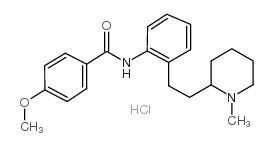Developmental electrophysiology of encainide and its major metabolites on the Purkinje fiber action potential.
C L Case, K W Hewett, P C Gillette
文献索引:Biol. Neonate 66(6) , 330-8, (1994)
全文:HTML全文
摘要
With clinical data suggesting that neonates may be more prone to developing electrophysiologic side effects from encainide, this study investigates the in vitro developmental electrophysiologic effects of encainide and its major metabolites on the action potential parameters of the canine cardiac Purkinje fiber.With standard microelectrode techniques, the in vitro tonic and rate-related effects of encainide, and its major metabolites (3-methoxy-4-hydroxy encainide, MODE, and O-dimethyl encainide, ODE) were investigated using mature and immature canine cardiac Purkinje fibers.The significant developmental differences in the effects of these compounds on the canine Purkinje fiber illustrated in this study are: (1) 1 x 10(-6) M encainide depresses Vmax in neonatal Purkinje fibers, yet not in the adult. (2) 1 x 10(-6) M MODE lengthens APD90 in the neonate, yet it has no substantial effect in the adult. (3) 1 x 10(-6) M ODE shortens APD90 in the adult, yet it has no appreciable effect on the neonate. (4) Rate-related effects of encainide and ODE are more pronounced in adult Purkinje fibers.In contrast to other in vitro studies on class I antiarrhythmic agents, neonatal canine Purkinje fibers seem to be more sensitive than the adult to the tonic depolarization depressant effect of encainide. This in vitro sensitivity parallels clinical experience with the drug in neonatal patients. Although encainide is no longer available for clinical use, these findings highlight the fact that the immature conduction system may show markedly different sensitivities to different class I agents despite the fact that these agents share similar qualitative pharmacologic properties.
相关化合物
| 结构式 | 名称/CAS号 | 分子式 | 全部文献 |
|---|---|---|---|
 |
恩舒尼盐酸盐
CAS:66794-74-9 |
C22H29ClN2O2 |
|
Encainide hydrochloride and flecainide acetate: two class 1c...
1987-11-01 [Clin. Pharm. 6(11) , 839-50, (1987)] |
|
ST segment elevation induced by class IC antiarrhythmic agen...
1998-11-01 [J. Cardiovasc. Electrophysiol. 9(11) , 1167-72, (1998)] |
|
Adherence and arrhythmic mortality in the cardiac arrhythmia...
1996-03-01 [Ann. Epidemiol. 6(2) , 93-101, (1996)] |
|
Antifibrillary action of class I-IV antiarrhythmic agents in...
1995-07-01 [J. Cardiovasc. Pharmacol. 26(1) , 132-6, (1995)] |
|
Impact of the Food and Drug Administration approval of fleca...
1997-01-01 [Am. J. Cardiol. 79(1) , 43-7, (1997)] |